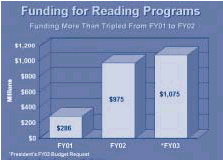First School Year for No Child Left Behind
The first school year under the historic, bipartisan No Child Left Behind Act is finally under way. Now, for the first time, the success of the public schools will be determined by the one measure that really matters—whether or not the children are learning.
The new law requires each state to implement a statewide accountability system that will set academic standards for what students should know and be able to do. It gives state and local officials the flexibility to find local solutions to local problems. The law encourages the use of curricula and teaching methods that are scientifically proven to work. No Child Left Behind provides extra help to students who are falling behind and offers parents options when their children are assigned to persistently underachieving schools.
You can read the text of the law at www.ed.gov/legislation/ESEA02. You may also want to review a parents' guide to the new law at www.NoChildLeftBehind.gov/next/faqs/index.html.
^ top ^
Rising from the Ashes
By Bernice Whelchel, Baltimore, Md.
"A phoenix rising from the ashes" was the hopeful description of City Springs Elementary School at the beginning of the 1997 school year. We had embarked upon our second year of school-wide reform efforts, and the jury was still out as to whether or not we would succeed. As a first-time principal, I was attempting to turn around a school widely believed to be one of the worst in Baltimore.
When we began our efforts, City Springs was not a safe place. Children and parents roamed the halls freely, teachers were threatened and often struggled just to get through the day. Student achievement had reached an all-time low and the school was under threat of state takeover. None of our students scored at the satisfactory level in reading and math on Maryland's state assessment, and we ranked 114 out of 115 on the Comprehensive Test of Basic Skills (CTBS).
Last year, six years after our efforts began, we were one of only two schools in Baltimore in the last 10 years to be removed from the state's watch list. Our overall state assessment scores rose to sixth in the city! Our median score for first-graders was in the 92nd percentile! We have the same student population as we did before: 98 percent qualify for free or reduced-price lunch. We are still in an area of Baltimore that is plagued by crime and drugs—but we are not the same school. If I hadn't experienced firsthand the painstaking efforts of our staff and students, I would call this turnaround nothing short of miraculous.
It is therefore with great excitement and satisfaction that we enter the 2002-2003 school year. We have high expectations for all students. Our school already meets many of the demands of No Child Left Behind. We have seen these reforms work, and we know they can work. President Bush, Secretary Paige and the U.S. Congress have united to bring new expectations, and that's encouraging. Until our school achieved such clear success during the last couple of years, we often felt that we were "renegades" for using direct instruction programs, in spite of their proven effectiveness. We had to resist pressure from various state and local agencies to enact teaching practices or curricula that we knew would be counterproductive to our students' progress. We knew that what we were doing worked, and we didn't want to risk our success on well-intentioned but unproven fads.
 |
 |  |  |
 | "Today begins a new era, a new time for public education in our country. Our schools will have higher expectations—we believe every child can learn. From this day forward, all students will have a better chance to learn, to excel, and to live out their dreams."
—President Bush, at the signing of the No Child Left Behind Act on January 8, 2002
|
|
|
No Child Left Behind gives this inner-city principal hope. Hope that this country will no longer accept the failure of poor children. Hope that educators will come to understand that we have enough examples of successful schools serving poor students to actually know what has to be in place for at-risk students to succeed. And, hope that, truly, no child will be left behind.
Bernice Whelchel, an educator for 32 years, is principal of City Springs Elementary School in Baltimore, Md. Last winter Whelchel served as a panelist on U.S. Secretary of Education Rod Paige's Reading Leadership Academy to share how a research-based curriculum turned a failing school into a successful one.
^ top ^
 No Child Left Behind:
No Child Left Behind:
How Student Achievement Is Measured
The first step toward creating a strong school accountability system is setting the bar for academic achievement. Under existing law, states are required to develop academic content standards for what every child should know and be able to do in reading and math. Many states already have rigorous academic standards in place, and most have adopted standards in other subjects like history and science. Once the standards are set, then the curriculum—the lessons and materials used in the classroom—can be aligned with those standards.

Source: House Education & the Workforce Committee |
Under No Child Left Behind, the success of the public schools will be measured by how well students are progressing toward and meeting the standards. Specifically, student progress will be measured in grades 3 through 8 by annual, statewide assessments aligned with the state reading and math standards. Testing annually is important because the results provide an independent measure of how much progress students have made toward meeting the academic content standards.
The assessment requirements under No Child Left Behind hold schools accountable for the achievement of all students. Test results show principals how much progress each teacher's students have made, so they can make good decisions about program selection, curriculum and professional development. Test results give parents information about the academic progress of their children and the quality of their children's schools. The results also help policy-makers and state and local leaders by providing critical information about which schools and school districts are succeeding and why.
^ top ^
Tips for Parents
Being involved in your children's education helps them do well in school and improves the quality of your school. Here are some suggestions for getting started. Find the time to get involved—it makes a difference!
- Take your child to school on the first day.
- Let your child know that school is important. Be sure to ask questions about homework, and set up a quiet place for your child to work.
- Read everything that is sent home from school—report cards, homework assignments, school lunch plans and vacation and bus schedules.
- Get to know your child's teachers and principal by attending school meetings and parent-teacher conferences.
- Encourage your child to read at home. Visit local and school libraries, stop at bookmobiles or go to book fairs to pick out books together.
^ top ^
Just Released! Helping Your Child Series

The U.S. Department of Education is reissuing Helping Your Child, a popular publication series for families and caregivers. The booklets have been updated with new information, including the latest research-based practices for helping children learn. These colorful booklets offer practical activities to stimulate children's learning and a list of resources such as books, computer programs and Web sites that adults and children can enjoy together.
Select titles of the 12-booklet series available this school year include Helping Your Child Become a Reader; Helping Your Preschool Child; Helping Your Child With Homework; Helping Your Child Through Early Adolescence, a new manuscript; and Helping Your Child Succeed in School. The first three, which are available in both English and Spanish, may be ordered through the Department's publication center at 1-877-4ED-PUBS, while supplies last.
Please visit www.ed.gov/pubs/parents/hyc.html for future availability of the full series.
^ top ^
| 



